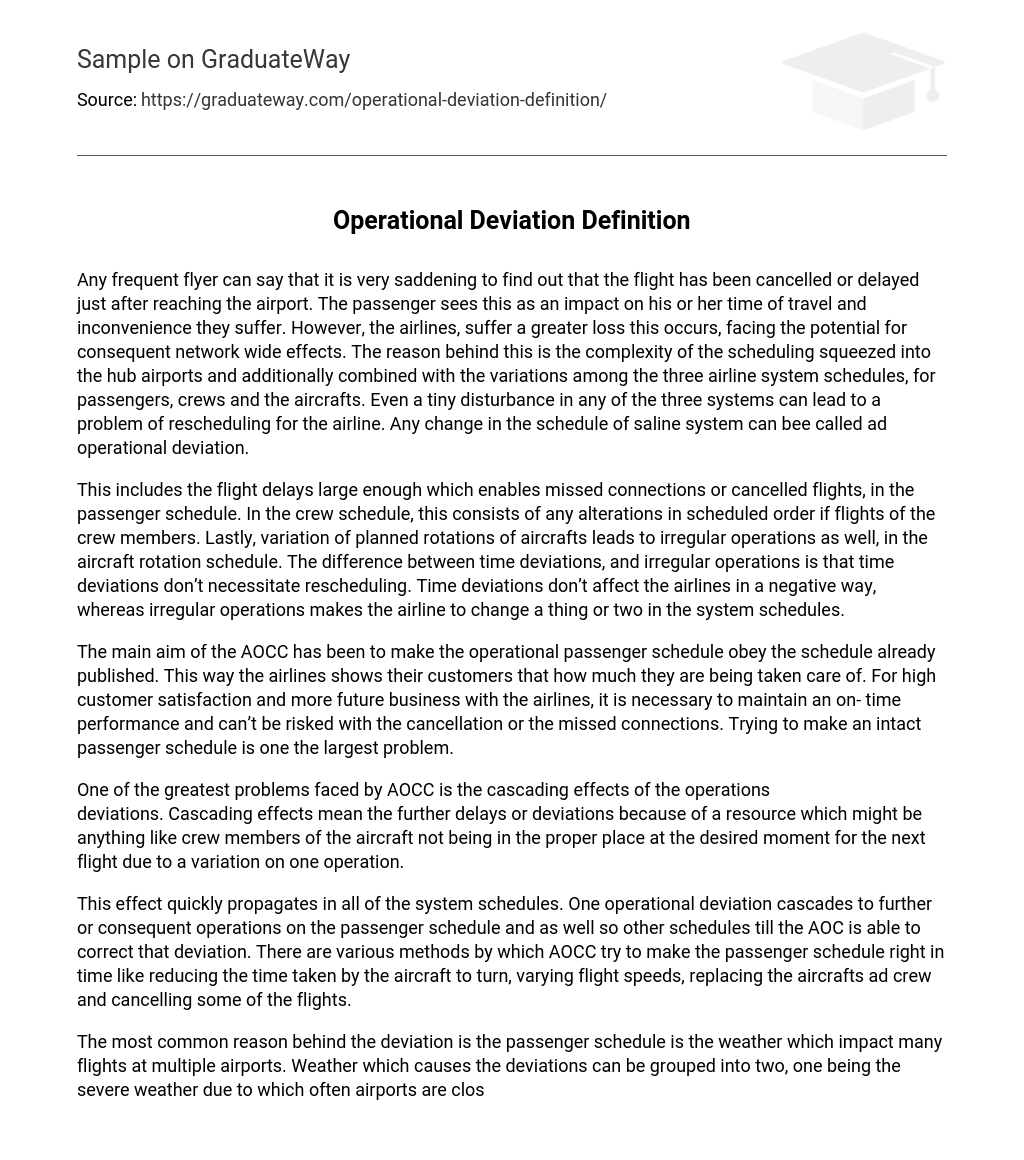Any frequent flyer can say that it is very saddening to find out that the flight has been cancelled or delayed just after reaching the airport. The passenger sees this as an impact on his or her time of travel and inconvenience they suffer. However, the airlines, suffer a greater loss this occurs, facing the potential for consequent network wide effects. The reason behind this is the complexity of the scheduling squeezed into the hub airports and additionally combined with the variations among the three airline system schedules, for passengers, crews and the aircrafts. Even a tiny disturbance in any of the three systems can lead to a problem of rescheduling for the airline. Any change in the schedule of saline system can bee called ad operational deviation.
This includes the flight delays large enough which enables missed connections or cancelled flights, in the passenger schedule. In the crew schedule, this consists of any alterations in scheduled order if flights of the crew members. Lastly, variation of planned rotations of aircrafts leads to irregular operations as well, in the aircraft rotation schedule. The difference between time deviations, and irregular operations is that time deviations don’t necessitate rescheduling. Time deviations don’t affect the airlines in a negative way, whereas irregular operations makes the airline to change a thing or two in the system schedules.
The main aim of the AOCC has been to make the operational passenger schedule obey the schedule already published. This way the airlines shows their customers that how much they are being taken care of. For high customer satisfaction and more future business with the airlines, it is necessary to maintain an on- time performance and can’t be risked with the cancellation or the missed connections. Trying to make an intact passenger schedule is one the largest problem.
One of the greatest problems faced by AOCC is the cascading effects of the operations deviations. Cascading effects mean the further delays or deviations because of a resource which might be anything like crew members of the aircraft not being in the proper place at the desired moment for the next flight due to a variation on one operation.
This effect quickly propagates in all of the system schedules. One operational deviation cascades to further or consequent operations on the passenger schedule and as well so other schedules till the AOC is able to correct that deviation. There are various methods by which AOCC try to make the passenger schedule right in time like reducing the time taken by the aircraft to turn, varying flight speeds, replacing the aircrafts ad crew and cancelling some of the flights.
The most common reason behind the deviation is the passenger schedule is the weather which impact many flights at multiple airports. Weather which causes the deviations can be grouped into two, one being the severe weather due to which often airports are closed for an extended period of time and the other is less severe weather that just causes delays and the operations tends to run at a slower pace.
The visibility problems, high winds or the conditions of the runway surface might not allow the airline operations run smoothly. At many a times, it is possible that there are no outgoing flights and only landing is possible at a slow rate or vice versa due to the factors like visibility and surface conditions of the runway. Here also, cascading effect on the schedule of consequent flights comes into play when the inbound flights are too delayed that are not possible to cancel and fly severely delayed.
Another reason the deviation in the passenger schedule is the problems caused by the ground service of the airline. This can b named as ground deviation. The ground support staff is responsible for baggage handling, moving cargo, refuelling of the aircrafts, handling of passengers and also equipment failures.
At the hub airport the process of baggage handling becomes much more complicated than that at a spoke airport as the majority of the passengers travelling through the hub airport are ought to catch the connecting flight and their luggage needs to go the process of loading, transferring and loading again to their connecting flights in so much less time. The problem gets even more complex when the same process is taking place for over a hundred flights simultaneously. From this, it is pretty much clear that, not only the equipment failure is responsible for the deviation, but the process of baggage unloading, pre-sorting and loading is also equally responsible for causing the deviations.
Scheduling of gates and the taxi time are two other potential sources for deviations. There are different types of gates and not each gate is capable of capacitate each and every aircraft. In some situations, even if an aircraft is on time, but some other aircraft is occupying its planned gate, and since due to there are no any other available gates to accommodate the particular aircraft, it can’t unload the passengers and the baggage in the specified or desired time thus causing the delay.
Taxi time means the time taken by the aircraft between pulling away from the gate and taking it off or between its landing and arrival at the gate. These vary based on the configuration of the runway, which might vary the distance to and from the gates. Usually, taxi times variation around 10 minutes is acceptable.





